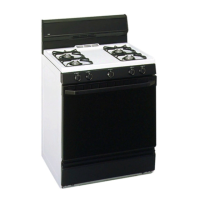c
i
“If a combination foils or fats will be used
in
frying, stirtoge er before heating or as fats
melt slow~y.
. Use a
deep fat the
?
ometerwheneverpossibleto
prevent overheatingfat beyond the smokingpoint.
I
cNever try tomove pan of hot fag especiallya
deepfktfryer.Wai untilthefat is cool.
!
.
uw proper P se
Avoid pans that are
unstable or easily pped. SeIect cookware having
fiat bottoms Iarge e ough to properly contain food
and avoid boilover and spillovers and large
enough to cover b
er grate. This will both save
cleaningtime and p vent hazardousaccumulations
of food, since hea spattering or spillovers left
on range can ignite Use pans with handles that
can be
easily grasp d and remain COOL
1
sWhen using glass o&ware, make sure it is
designed for top-of range cooking.
● Keep ali plastics a~ay from the top burners.
{
● Do not leave plas c
itemsonthecook p-
theymay melt if le
@
1
oo-close to the ven.
.
,
e
Vent appearance and location vary
4
GDo not leave any i ms on the cooktop.
Thehot air
horn th vent may ignite flammable
items and Will in
e pressure in closed
containers, which
y cause them to burst.
-4
cTo avoid the possi ility of a b- always be
certain that the co trols for all burners are at
the off position an all grates are cool before
attempting to rem ve them.
● -n
“f
are under the ho@ turn ~
the fan off. The f , if operating, may spread
the flames.
4-
—.-
● If range is located ear a yindow, do not hang
long curtains that c &i blow over the top burners
andcreateafire d.
}
cWhen a pilot goes ut (on standingpilot models),
you will detect a f
● t odor of gas as your signal
to relight the pilot.
en relighting the piIot,
make sure burner c ntrols are in the off position,
and follow instructi ns in this book to relight.
!iiiM
● Myou smell gas, d you have already made sure
pilots are lit (ons
“ g pilot models),turnoff the
w
totherangeand
a qualifiedservicetechnician.
ever use an open
to hxate a leak.
F
Baking, Broiling d Roasting
● Keep the oven free from grease buildup.
T!!
● Do not use the oven for a storage area.
Items stored in
the oven can ignite.
QPlace the oven shelves in the desired position
while the oven is cod.
● Stand away from the range when opening the
door of a hot oven. Thehot air and steam that
escapes can cause bums to hands, face and eyes.
● “
Pullingout the shelfto the shelf-stopis a
conveniencein lifting heavy foods. It is also a
precaution against burns from touching hot
surfaces of the door or oven walls. The lowest
position “R” is not designed to slide.
● Do not heat unopenedfood containers.Pmsure
couldbuildup andthe container
could burs~
causing an injury.
● Do not use ahunim.m foil anywhere in the owm
except as described in this guide.
Misuse could
result in a f~e hazard or damage to the range.
● When using cooking or roasting bags in the
oven, follow the manufacturer’s directions.
● Use only glass cookware that is recommended
for use in gas ovens.
● Always remove the broiler pan from range as
soon as you finish broiling. Greaseleft
in the pan
can catch fue if oven is used without removing
the grease from the broiler pan.
● When broiling, if meat is too close to the flame,
the fat may ignite. Trimexcess fat to prevent
excessive flare-ups.
● Make sure the broiler pan is in place correctly
to reduce the possibility of grease fins.
. u YOUshodd have
a grease fin in the broiler
p@ turn off oven con~ol, and keep broiler
drawer and oven door closed to contain fmeuntil
.-
it
burns out.
Cl-g
Your Range
●Ckxmonlypartslistedin thisUseand CareGuide.
● Keep range clean and free of accumulations of
grease or spillovers, which may ignite.
● Be careful when you clean the cooktop because
the area over thepilot (onstandingpilot modeh)
will be hot.
SAW THESE
,,
INSTRUCTIONS
I
u

